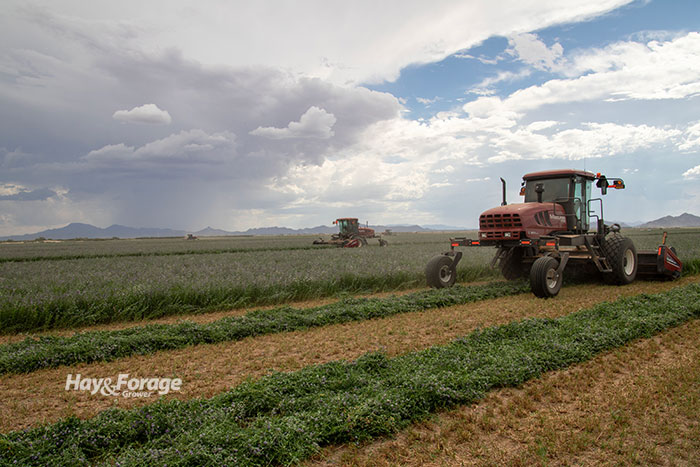
A dry start to the growing season made for smooth sailing as many hay producers cut forage without worrying their crop would be rained on. With rain returning to the radar in some regions, though, weather conditions could interfere with upcoming hay harvests.
In a recent issue of the Forage News newsletter from Mississippi State Extension, Rocky Lemus reminds readers the optimal forage moisture for baling hay is approximately 15%. The forage specialist says the time it takes hay to reach this threshold depends on plant species, forage density, cutting equipment, and precipitation; however, not all rain events impact hay the same way.
Rained-on hay that was just cut may be less concerning than rained-on hay that is drier and closer to baling. Forage in the latter situation is more susceptible to nutrient leaching, which lowers dry matter and energy levels and raises fiber content. Drier hay is also more likely to lose energy through respiration if it is rained on and moisture levels return to 30% or above as microbial activity ramps up and bacteria consumes plant sugars.
Lemus notes repeated precipitation has shown to cause more damage to hay than one rain event, but delaying harvest to avoid a single shower may not be a good idea. Although doing so might avoid wetness and boost forage yield, forage quality could decline more in standing forage than if cut hay received as much as 3 inches of rain.
Other factors
In addition to rain, three other environmental factors that can have a major effect on hay production are relative humidity, dew point, and soil moisture. Harvesting hay when one or more of these metrics is too high will delay dry down and thus reduce forage quality.
Relative humidity measures the amount of water vapor in the atmosphere relative to how much is required to reach saturation at the same temperature. For this reason, a high relative humidity limits evaporation rates in forage.
“The air moving on top of the drying hay must be able to absorb the evaporating water, with the air in the atmosphere acting as a sponge or a mop. This is difficult to achieve when air humidity levels are above 60%,” Lemus explains. “An optimal hay drying process can only be achieved on sunny, warm days where heat has the effect of lowering the relative humidity and increasing the rate at which water evaporates from the plant.”
High dew points can also impede dry down. Lemus points out water droplets are fast to form on plant leaves and stems on clear nights when air temperatures reach the dew point quickly. Moreover, high soil moisture can limit dry down by keeping the bottom layer of hay wet. In this case, it is best to spread forage out in wide swaths after cutting.
Considering these risks, Lemus reiterates the trade-off between yield and quality when harvest is delayed in an attempt to shorten the drying period. “Cutting at a very early maturity can result in forage crops with higher moisture content and more drying time might be required,” he asserts. “On the other hand, mature crops tend to have less moisture, but at the same time, higher fiber content and lower nutritive value. Therefore, balancing biomass production and nutritive value are important components of the haymaking process.”

